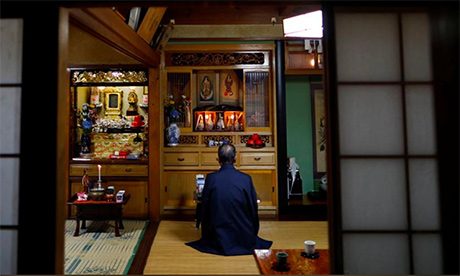His face weathered from years at sea, kimono-clad Japanese fisherman Masaichi Kawasaki kneels before an altar adorned with images of the Virgin Mary, crossing himself as he softly intones chants handed down through centuries.
Kawasaki, 69, is one of a dwindling number of Japan’s “Kakure Kirishitan,” or “Hidden Christians,” descendants of those who preserved their faith in secret during centuries of persecution.
His unique faith blends Buddhist, Christian and Shinto practices, and its ritual chants combine Latin, Portuguese and Japanese.
The Hidden Christians have garnered fresh attention ahead of Pope Francis’s visit to Japan on Nov. 23-26, with domestic media and a French broadcaster heading to Nagasaki to report on them. Last year, 12 Hidden Christian-related locations were designated UNESCO World Heritage sites.
But their religion may be on the verge of extinction as youth leave rural areas, where the faith has persisted.
“I worry that what my ancestors worked hard to preserve will disappear, but that is the trend of the times,” said Kawasaki, who prays each evening at home before the altar, flanked by others devoted to Buddhist and Shinto gods.
“I have a son but I don’t expect him to carry on,” he added. “To think this will disappear is sad, without a doubt.”
Centuries of suppression
Jesuits brought Christianity to Japan in 1549, but it was banned in 1614. Missionaries were expelled and the faithful were forced to choose between martyrdom or hiding their religion.
Many joined Buddhist temples or Shinto shrines to disguise their beliefs, and some rites such as confession and communion, which require a priest, disappeared.
Other rituals blended with Buddhist practices such as ancestor worship or indigenous Shinto ceremonies.
Handed down orally and in secret, “orasho” chants – from “oratio” in Latin – combined Latin and Portuguese with Japanese, their meanings mostly symbolic.
When Japan’s ban on Christianity was lifted in 1873, some Hidden Christians joined the Catholic Church; others opted to maintain what they saw as the true faith of their ancestors.
“They didn’t want to destroy the faith they had preserved all along despite suppression,” said Shigenori Murakami, the seventh-generation head of a group of Hidden Christians in Nagasaki City’s Sotome district, the setting for Martin Scorcese’s 2016 movie “Silence” about persecuted Christians.
Pope Francis is expected to speak of Hidden Christians when he visits a martyrs’ monument on Nishizaka Hill in Nagasaki, southwest Japan, where 26 Christians were executed in 1597.
“I think there is a high likelihood that he will send a message about the Hidden Christians,” whom he has mentioned in the past, Kagefumi Ueno, a former Japanese envoy to the Vatican, told reporters.
“The pope has said the fact that in Japan there were Christian people who maintained their beliefs for two and a half centuries under great suppression holds a big lesson for the present.” Continue reading
Additional readingNews category: Analysis and Comment.




